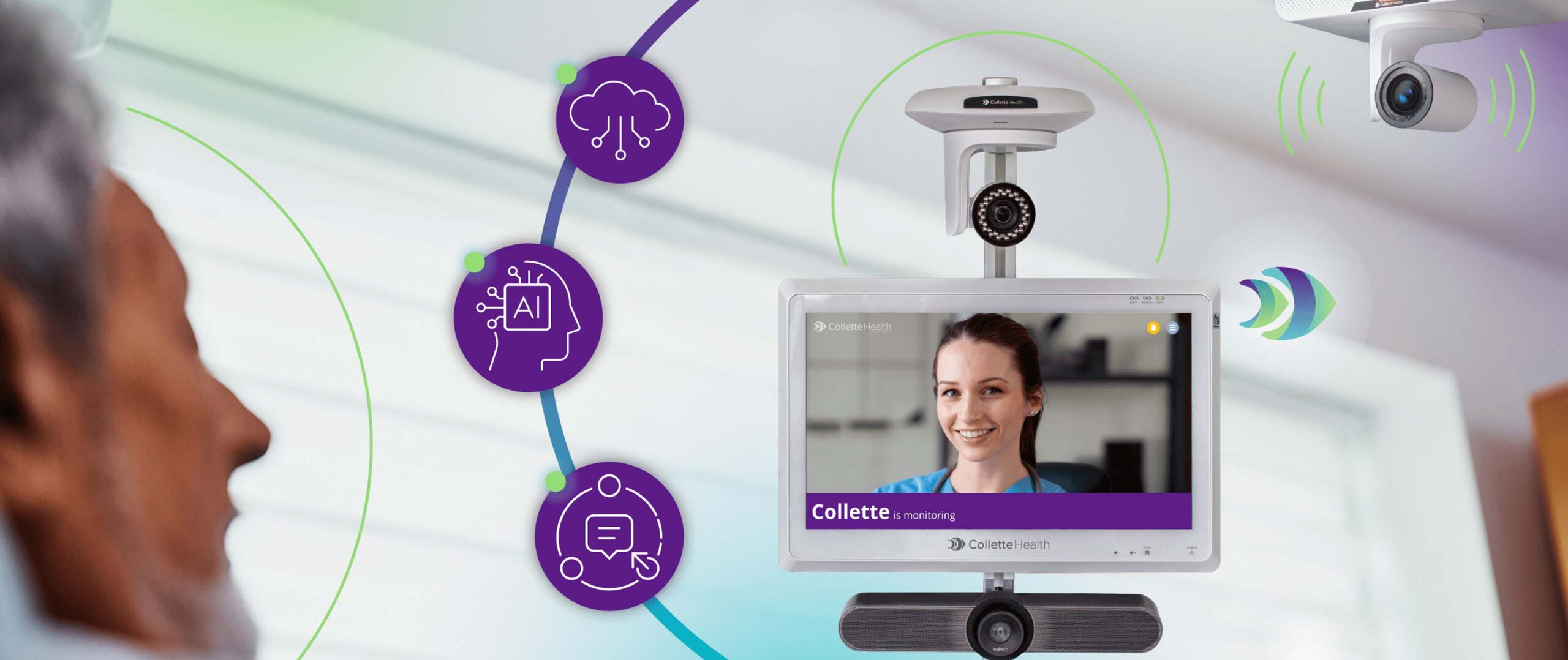Human Connection Changes Everything
At Collette Health, we amplify human connection with AI-enhanced virtual care solutions.
Together, our virtual observation, virtual nursing, and workforce augmentation solutions empower you to provide your patients with safer, more effective care with measurable outcomes.


Patients are safer
when they’re more connected with caregivers
Virtual Observation
- Prevents patient falls
- Reduces hospital-acquired
pressure injuries - Reduces social isolation
- Detects contraband
- Protects medical devices
- Improves staff safety
- Prevents patient elopement

when their workflows are streamlined
Virtual Nursing
- Supports admissions and discharges
- Improves family accessibility
- Supports team care models and specialized bedside care
- Deepens documentation abilities
- Supports patient education
- Boosts virtual rounding
- Empowers top-of-license practice
More human connection provides measurable results
Collette Health partners with you to design, develop, and deploy virtual care programs that augment your workforce and improve outcomes.
Virtual care, amplified by human-centered AI and machine learning.

Collette Health has been ranked #1 for Virtual Sitting & Nursing in the 2025 Best in KLAS Report!

Healthcare leaders love our solution
A Cutting-Edge Platform

Reliable Cloud-Native Architecture
Reliable Cloud-Native Architecture
- Reduces the burden on your IT team
- Provides fully customizable flexibility
- Deploys real-time updates
- Increases the security of your data
Human-centered Artificial Intelligence (AI)
Human-centered Artificial Intelligence (AI)
- Enhances proactive patient interventions
- Augments human detection of patient risks
- Improves documentation compliance
- Empowers access to ethical AI
Integrated Virtual Visits
Integrated Virtual Visits
- Provides instant access to specialists, family, or clergy
- Offers reliability built into the software
- Prevents social isolation
- Enables interfacility bedside reporting
Effective Virtual Care Solutions

- Prevent falls and adverse events
- Reduce hospital-acquired pressure injuries
- Address multiple risks simultaneously
- Protect clinical staff, patients, and families from violence
Virtual Nursing

- Lighten clinical workloads
- Connect any patients with anyone, anytime
- Augment hourly rounding and clinical presence
- Empower efficient documentation
Virtual Workforce Augmentation
extend your care team

- An extension of your care team
- Expertly trained observers
- Impact outcomes from the start
- Support virtual nursing care models
Professional Services
create custom programs

- Assess the efficacy of your virtual program
- Design, develop, and deploy virtual care programs
- Build custom analytics and benchmarking
- Create specialized clinical programs

Virtual connections that change human outcomes
Contraband Prevention
A Virtual Patient Observer noticed suspicious activity in a patient's room, where a visitor was seen handing something to the patient and quickly hiding it under the blanket. The Virtual Patient Observer alerted staff immediately to prevent any unauthorized or dangerous items from being used. A lighter was subsequently removed from the room.Seizure
When a patient’s hands started shaking and they showed signs of a potential seizure, our Virtual Patient Observer immediately raised the alarm. This prompt action ensured the medical team was in the room within seconds to provide care.Fall Prevention
A patient was attempting to get out of bed unassisted. Our Virtual Patient Observer quickly recognized the situation and used verbal redirection, calmly reminding the patient to stay in bed. The patient said they needed to go to the bathroom, so the observer requested that the patient wait in bed for help, then contacted the nurse, and when the nurse arrived, the medical staff turned on privacy mode. Thanks to the Virtual Patient Observer's swift response, a potential fall was avoided.More than 170 hospitals and healthcare systems trust Collette Health’s innovative platform to keep their patients and staff connected.
See it in action!
Patients are safer when they’re more connected with caregivers, and nurses are more efficient when their workflows are streamlined.
Collette Health partners with you to design, develop, and deploy virtual care programs that augment your workforce and improve outcomes.
From a cutting-edge virtual observation platform to virtual nursing services, Collete Health helps your hospital or health system drive better patient outcomes.
- Schedule
- Demo
- Discover
- Follow Up
Who are we?
Collette Health’s vision is to improve clinical outcomes by amplifying human connection through innovative technologies.
